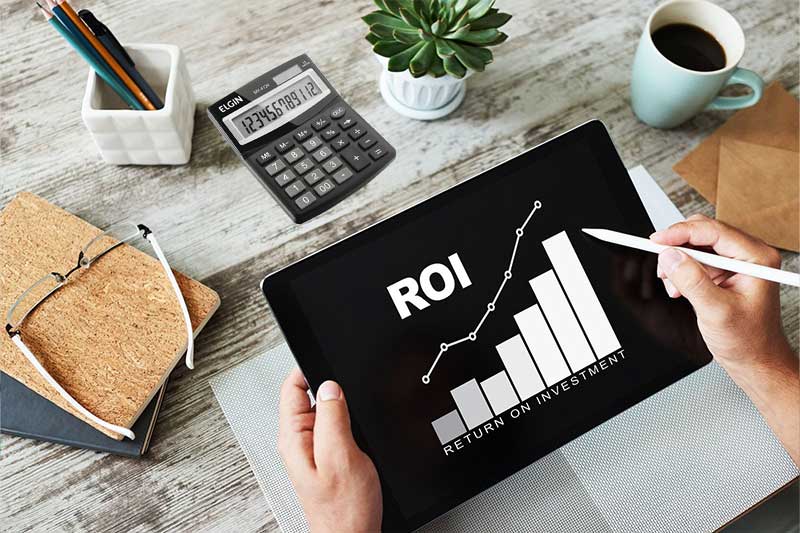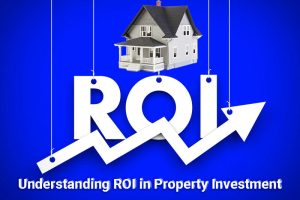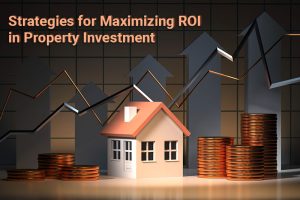
Do you want to make informed decisions when investing in property?
Calculating the return on investment (ROI) of a property is essential to understanding its potential profitability and making smart investment choices.
Let’s dive into this comprehensive guide on how to calculate rental yield and maximize your ROI of property investment.
Short Summary
- Rental yield and capital growth are key components of Return on Investment (ROI) for property investors to consider.
- An investment property calculator is a useful tool that helps estimate returns, expenses, and yields when evaluating potential investments.
- Strategies such as diversification, consideration of taxable income implications, and regular review & maintenance can help maximize ROI in property investment.
Understanding ROI in Property Investment
 Return on investment is the expected return a property investor receives from a property. It is calculated using the formula: ROI = (gain on investment – cost of investment) / cost of investment. The two primary methods for calculating ROI in property investment are the cost method and the out-of-pocket method, which take into account cash flow and other factors.
Return on investment is the expected return a property investor receives from a property. It is calculated using the formula: ROI = (gain on investment – cost of investment) / cost of investment. The two primary methods for calculating ROI in property investment are the cost method and the out-of-pocket method, which take into account cash flow and other factors.
In the world of property investment, rental yield, and capital growth are the key components that determine ROI. Many investors aim for returns that match or exceed the average returns of major stock market indices, such as the S&P 500, which is typically around 10%. Before purchasing a property, it’s essential to estimate costs, expenses, and rental income to make informed decisions.
Key Components of ROI
Rental yield is the income generated from a property before expenses. Capital growth, on the other hand, refers to the increase in the value of the asset over time. These two components make up the ROI and are crucial in evaluating the profitability of property investment.
For example, gross rental yields in regional areas can be 5% or more. Furthermore, investing in Real Estate Investment Trusts (REITs) allows investors to pool their funds and invest in a diverse portfolio of real estate properties, potentially increasing the overall ROI.
Importance of ROI for Property Investors
ROI is a paramount measurement for property investors to evaluate the efficacy of their investments and compare them with other investment options. For instance, dividends from REITs are taxable at the same rate as ordinary income, while capital gains distributions are typically taxed at a lower rate for capital gains.
One of the benefits of investing in property is negative gearing, where any loss incurred each financial year from the property can be applied as a deduction against the income earned, thereby reducing taxable income and the amount of tax paid. This tax benefit can significantly impact the overall ROI of a property investment.
Gross Rental Yield vs. Net Rental Yield

By calculating both gross and net rental yield, investors can gain insights into the property’s rental return, potential cash flow, and overall ROI. This knowledge can be invaluable when comparing different investment properties and making well-informed decisions.
Calculating Gross Rental Yield

This is an important metric for investors to consider when evaluating potential rental properties, as it can provide valuable information.
Calculating Net Rental Yield
Net rental yield takes into consideration property expenses and is calculated by dividing net rental income by the market value of the property. This calculation provides a more accurate representation of the property’s rental return, as it factors in expenses such as:
- Property maintenance
- Insurance
- Rates
- Property management
- Repairs
- Transaction costs
These expenses can significantly reduce the return on investment, so it is important to factor them into the return on investment.
Using an Investment Property Calculator

- Council rates
- Strata fees
- Insurance
- Repairs
By using investment property calculators, investors can make informed decisions.
One essential aspect of investment property calculators is the calculation of the Internal Rate of Return (IRR). IRR is an annual rate of return earned on each dollar invested for the duration of the investment. A higher IRR indicates a more desirable investment, allowing investors to compare different investment options effectively.
Features of Investment Property Calculators
Investment property calculators have various features that enable users to:
- Input diverse financial data
- Customize calculations based on individual investment scenarios
- Estimate the cost of the property
- Calculate cash operating revenue and expenses
- Estimate return on investment
- Provide a net operating estimate for the initial year
By using these features, property investors can:
- Gain valuable insights into the financial aspects of their investments
- Make better decisions on which properties to invest in
- Track their portfolio’s performance over time
- Adjust their investment strategies accordingly.
Tips for Choosing the Right Calculator
When selecting an investment property calculator, consider factors such as ease of use, accuracy, and the ability to compare different investment properties. It is essential to choose a calculator that provides accurate results, as fluctuations in market value, unforeseen expenses, and variations in rent can significantly impact the precision of rental property calculators.
Remember that the results obtained from investment property calculators are estimates and should be used as a reference. It’s always a good idea to consult with financial advisors and professionals to ensure the accuracy and reliability of the information provided by these
Factors Affecting ROI of Property Investments

- Market value
- Operating expenses
- Repair costs
- Effective property management
These factors can impact the net rental yield and overall ROI, making it crucial for investors to consider them when assessing potential investments
By understanding these factors and their effects on ROI, property investors can:
- Make more informed decisions
- Select investments that are likely to yield higher returns
- Identify potential issues
- Take proactive steps to address them
- Ensure their investments remain profitable over time
This knowledge can help investors make better investment choices and maximize their returns.
Market Value and Purchase Price
Market value and purchase price play a significant role in determining the potential ROI of property investment. The market value and purchase price of a property directly influence its ROI, as calculated by comparing the amount invested in the property, including the purchase price, to its current market value.
If the market value of the property increases over time, the return on investment will be higher. Conversely, if the purchase price is high relative to the market value, the return on investment may be lower. Investors should consider these factors when assessing potential investments and making informed decisions.
Operating Expenses and Repair Costs
Operating expenses, including maintenance costs, and repair costs, can significantly impact the net rental yield and overall ROI of a property investment. Some common operating expenses include:
- Management costs
- Repairs
- Janitorial services
- Maintenance
- Legal fees
- Accounting costs
These expenses are subtracted from the gross income to calculate the net operating income (NOI).
It is essential to consider these expenses when assessing a property’s potential ROI. Regular property maintenance and timely repairs can help minimize operating expenses and maximize net rental yield. This, in turn, contributes to a higher overall ROI.
Effective Property Management
Effective property management is crucial for maximizing ROI by minimizing vacancies, maintaining the property, and ensuring a steady rental income. To reduce vacancies, maintain the property to a high standard, market the property efficiently, and provide competitive rental rates.
Regular property inspections, prompt addressing of maintenance issues, and timely repairs are essential for ensuring the property’s upkeep. By providing excellent customer service and maintaining the property’s attractiveness, investors can guarantee consistent rental income and higher ROI.
Strategies for Maximizing ROI in Property Investment

Each of these strategies plays a vital role in maximizing ROI, and investors should consider all aspects when making investment decisions. By taking a holistic approach and considering all factors, property investors can achieve higher returns and long-term success in the property investment market.
Diversifying Your Property Portfolio
Diversifying your property portfolio can help mitigate risk and increase the potential for higher returns. By investing in different types of properties, locations, and asset classes, investors can optimize their return on investment.
Some examples of diversification include:
- Investing in residential, commercial, and industrial properties
- Investing in urban, suburban, and rural locations
- Investing in different countries
- Investing in different asset classes, such as stocks, bonds, and real estate investment trusts (REITs)
Diversification helps spread risk and can lead to more stable returns.
Taxable Income Considerations
Taxable income considerations, such as negative gearing and capital gains tax, can impact the overall ROI of property investment. Negative gearing allows investors to deduct any loss incurred each financial year from the property against their income, reducing taxable income and the amount of tax paid.
Capital gains tax is another consideration when evaluating the potential ROI of a property investment. The tax rate applied to investment income can reduce the total return on investment, making it essential to understand the tax implications and incorporate them into the ROI calculation.
Regular Property Review and Maintenance
Regular property review and maintenance play a crucial role in ensuring the property remains attractive to tenants and maintains its value, contributing to a higher ROI. Regular inspections, addressing maintenance issues promptly, and attending to necessary repairs in a timely manner help preserve the property’s condition.
By keeping the property well-maintained and monitoring market trends and changes in the local area, investors can ensure their properties remain profitable and achieve higher rental rates. Regular property review and maintenance are essential strategies for maximizing ROI in property investment.
Summary
In conclusion, understanding and calculating ROI in property investment is essential for making informed decisions and maximizing returns. By considering factors such as rental yield, capital growth, market value, operating expenses, and effective property management, investors can optimize their ROI and achieve success in the property market. Employing strategies such as diversifying property portfolios, taking into account taxable income considerations, and regularly reviewing and maintaining properties can further enhance the potential for higher returns. With the right approach and strategies, property investors can unlock the full potential of their investments and reap the rewards of a successful property portfolio.
Frequently Asked Questions

What is a good ROI for property investment?
A rate of return of between 8-10% per annum is generally considered a great ROI for property investment, so investors should be aiming for this mark when evaluating their potential returns.
Investors should consider the location of the property, the rental yield, the potential for capital growth, and the costs associated with the investment when assessing the potential returns.
It is also important to factor in the potential for unexpected costs, such as repairs and maintenance.
What is a good rate of return on rental property Australia?
Overall, a good rate of return on rental property in Australia is between 7% and 13%, depending on the capital city suburbs or regional areas.
How is ROI calculated?
Return on Investment (ROI) is calculated by subtracting the initial cost of the investment from its final value, dividing this new number by the cost of the investment and multiplying the result by 100.
This approximate measure of an investment’s profitability provides a quick assessment of how much money was gained or lost from an investment.
How do you calculate real estate?
Real estate ROI can be calculated by comparing the amount invested in the property to its current value, or by dividing net operating income by the total property price. This gives a cap rate which should typically fall between 5-10% for a good return.
What is the difference between gross rental yield and net rental yield?
Gross rental yield is the total income generated from a property prior to deductions, while net rental yield takes into account all expenses associated with owning the property to provide a more accurate assessment of returns.
By understanding the difference between gross and net rental yields, investors can make more informed decisions when it comes to investing in property.












